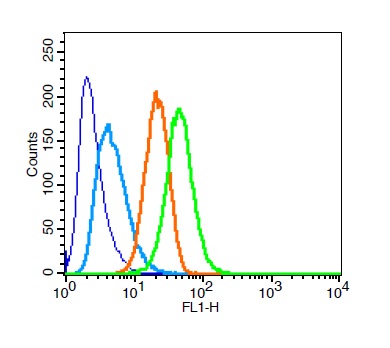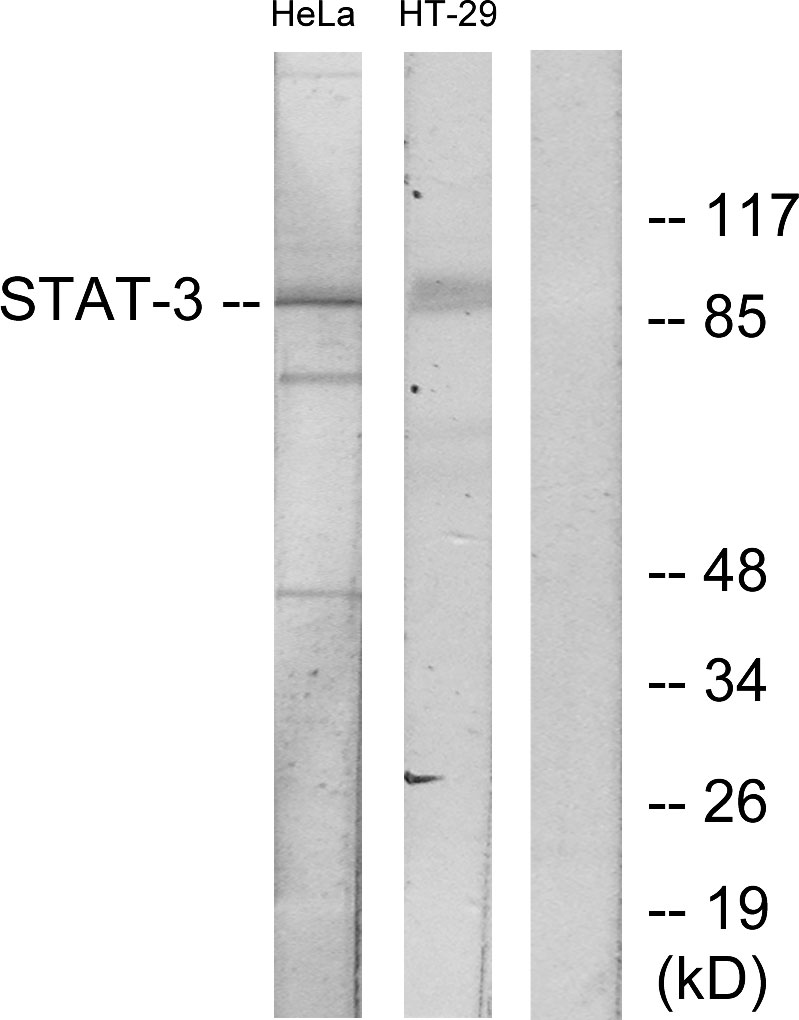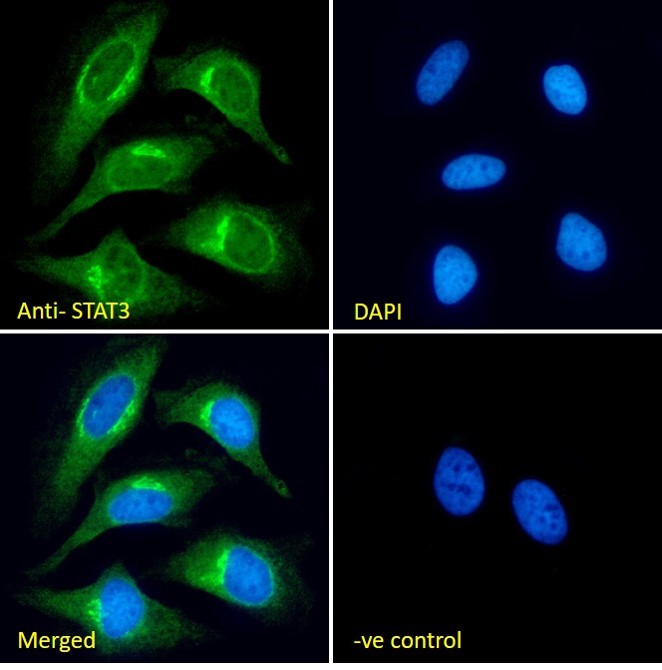STAT3 antibody [C3], C-term
GTX104616
ApplicationsImmunoFluorescence, Western Blot, ImmunoCytoChemistry, ImmunoHistoChemistry, ImmunoHistoChemistry Paraffin
Product group Antibodies
ReactivityHuman, Mouse, Plant, Rat
TargetSTAT3
Overview
- SupplierGeneTex
- Product NameSTAT3 antibody [C3], C-term
- Delivery Days Customer9
- Application Supplier NoteWB: 1:500-1:3000. ICC/IF: 1:100-1:1000. *Optimal dilutions/concentrations should be determined by the researcher.Not tested in other applications.
- ApplicationsImmunoFluorescence, Western Blot, ImmunoCytoChemistry, ImmunoHistoChemistry, ImmunoHistoChemistry Paraffin
- CertificationResearch Use Only
- ClonalityPolyclonal
- Concentration0.48 mg/ml
- ConjugateUnconjugated
- Gene ID6774
- Target nameSTAT3
- Target descriptionsignal transducer and activator of transcription 3
- Target synonymsADMIO, ADMIO1, APRF, HIES, signal transducer and activator of transcription 3, DNA-binding protein APRF, acute-phase response factor
- HostRabbit
- IsotypeIgG
- Protein IDP40763
- Protein NameSignal transducer and activator of transcription 3
- Scientific DescriptionThe protein encoded by this gene is a member of the STAT protein family. In response to cytokines and growth factors, STAT family members are phosphorylated by the receptor associated kinases, and then form homo- or heterodimers that translocate to the cell nucleus where they act as transcription activators. This protein is activated through phosphorylation in response to various cytokines and growth factors including IFNs, EGF, IL5, IL6, HGF, LIF and BMP2. This protein mediates the expression of a variety of genes in response to cell stimuli, and thus plays a key role in many cellular processes such as cell growth and apoptosis. The small GTPase Rac1 has been shown to bind and regulate the activity of this protein. PIAS3 protein is a specific inhibitor of this protein. Three alternatively spliced transcript variants encoding distinct isoforms have been described. [provided by RefSeq]
- ReactivityHuman, Mouse, Plant, Rat
- Storage Instruction-20°C or -80°C,2°C to 8°C
- UNSPSC12352203
References
- Wang BY, Shen HT, Lee YL, et al. Inhibition of Na+/H+ exchanger (NHE) 7 by 5-(N-ethyl-N-isopropyl)-Amiloride displays anti-cancer activity in non-small cell lung cancer by disrupting cancer stem cell activity and downregulating PD-L1 expression. Am J Cancer Res. 2023,13(10):4721-4733.Read this paper
- Liao CP, Hsieh YC, Lu CH, et al. Methoxyhispolon Methyl Ether, a Hispolon Analog, Thwarts the SRC/STAT3/BCL-2 Axis to Provoke Human Triple-Negative Breast Cancer Cell Apoptosis In Vitro. Biomedicines. 2023,11(10). doi: 10.3390/biomedicines11102742Read this paper
- Hsieh YC, Dai YC, Cheng KT, et al. Blockade of the SRC/STAT3/BCL-2 Signaling Axis Sustains the Cytotoxicity in Human Colorectal Cancer Cell Lines Induced by Dehydroxyhispolon Methyl Ether. Biomedicines. 2023,11(9). doi: 10.3390/biomedicines11092530Read this paper
- Hsu CY, Yang WT, Lin JH, et al. Sertindole, an Antipsychotic Drug, Curbs the STAT3/BCL-xL Axis to Elicit Human Bladder Cancer Cell Apoptosis In Vitro. Int J Mol Sci. 2023,24(14). doi: 10.3390/ijms241411852Read this paper
- Cardile A, Zanrè V, Campagnari R, et al. Hyperforin Elicits Cytostatic/Cytotoxic Activity in Human Melanoma Cell Lines, Inhibiting Pro-Survival NF-κB, STAT3, AP1 Transcription Factors and the Expression of Functional Proteins Involved in Mitochondrial and Cytosolic Metabolism. Int J Mol Sci. 2023,24(2). doi: 10.3390/ijms24021263Read this paper
- Kuo MY, Yang WT, Ho YJ, et al. Hispolon Methyl Ether, a Hispolon Analog, Suppresses the SRC/STAT3/Survivin Signaling Axis to Induce Cytotoxicity in Human Urinary Bladder Transitional Carcinoma Cell Lines. Int J Mol Sci. 2022,24(1). doi: 10.3390/ijms24010138Read this paper
- Mang Y, Zhang S, Zhao J, et al. Characteristics of pre-sensitization-related acute antibody-mediated rejection in a rat model of orthotopic liver transplantation. Ann Transl Med. 2022,10(19):1066. doi: 10.21037/atm-22-4311Read this paper
- Tangeda V, Lo YK, Babuharisankar AP, et al. Lon upregulation contributes to cisplatin resistance by triggering NCLX-mediated mitochondrial Ca(2+) release in cancer cells. Cell Death Dis. 2022,13(3):241. doi: 10.1038/s41419-022-04668-1Read this paper
- Raineri A, Campagnari R, Dal Toso R, et al. 3,5-Dicaffeoylquinic Acid Lowers 3T3-L1 Mitotic Clonal Expansion and Adipocyte Differentiation by Enhancing Heme Oxygenase-1 Expression. Molecules. 2021,26(16). doi: 10.3390/molecules26165027Read this paper
- Zhang L, Sui C, Zhang Y, et al. Knockdown of hsa_circ_0134111 alleviates the symptom of osteoarthritis via sponging microRNA-224-5p. Cell Cycle. 2021,20(11):1052-1066. doi: 10.1080/15384101.2021.1919838Read this paper








![WB analysis of NIH-3T3 cell extracts with/without TNF-alpha (20 ng/ml, 37oC, 30 min) treatment using GTX00966 STAT3 (phospho Tyr705) antibody [GT1204]. Dilution : 1:1000 Loading : 25microg](https://www.genetex.com/upload/website/prouct_img/normal/GTX00966/GTX00966_20200327_WB_1_w_23053121_254.webp)